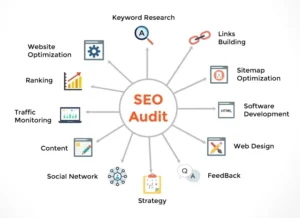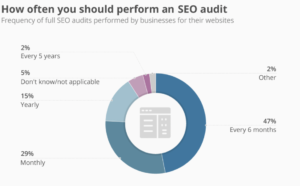How often should you do an SEO audit?
It’s something new or potential clients ask us often.
In this post we’ll breakdown the types of audits you should do and how regularly, but first, what are they exactly?
What is an SEO Audit?

An SEO audit is a careful process that involves analysing a website’s ability to index, rank and perform well in search engines. A comprehensive audit includes identifying strengths to leverage, spotting weaknesses that need to be remedied or removed, and making a clear path to improvement.
A comprehensive SEO audit needs to cover all important aspects of search engine optimisation in order to confirm that a site is upholding the most important SEO best practices, or at least to identify those that are missing. Less comprehensive SEO audits may focus on specific areas, for example a technical SEO audit may only focus on the technical issues preventing a site from performing well, rather than its overall SEO strategy.
Before we go deeper, let’s quickly cover what is included in an SEO audit:
Technical SEO Audit
- Site Structure: Checking that the overall site structure is clean, easy to navigate and crawl, and provides a high quality user experience
- Mobile Usability: Checking how the site displays, works and responds across multiple device and screen sizes, with a focus on speed and layout
- Search Console/AHrefs Errors: Spotting crawl errors, broken redirects, slow loading content, security issues, etc.
- Basic Web Performance & Vitals: Is the site working in in terms of interactivity, does it load quickly, are canonical tags correct?
On Page SEO Audit
- Content Relevance and Quality: Each individual page or blog post needs to be high quality, readable, authoritative, and contain relevant information to the topic it’s trying to rank for. Google judges this by the language used so be sure to use as many relevant keywords as possible.
- Meta Tags: Titles and descriptions need to not only match the content of the page as accurately as possible, but should essentially be used as a free ad, using copywriting skills to draw users to click on the page.
- Internal Links: The link structure must be analysed and improved in order to ensure it offers both easy navigation and appropriate distribution of page authority.
- Headers: Headers must be used appropriately to structure content, with it being clear which sections are the focal point of each post and navigation throughout the content being logical and natural. Effective use of headers can improve readability, accessibility, and give an opportunity to rank for more relevant keywords beyond the focal key phrase.
- Images: Images must be compressed correctly for optimal loading times, have clear descriptive file names and alt tags, and be relevant to the pages they’re displayed on, adding to the depth or readability of each content piece.
- Site Architecture: Sitemaps must be current for optimal crawlability, robots.txt should be implemented effectively to direct crawls, and connections should be secure with HTTPS for trust (this helps with ranking too).
- URLs: URLs should be clear, relevant to the page, concise, easy to read and contain the main keyword you’re trying to rank for.
Off Page SEO Audit:
- Backlinks: If you have any experience with SEO at all, you’ll be aware that they are one of the most important metrics when it comes to ranking in competitive keyword and gaining relevant traffic. If a site or page doesn’t have enough backlinks, it won’t be visible in high positions in search engines. If everything else is done right already, then pointing some extra backlinks can be the difference between success and failure.
- Rankings: Why rankings are the goal, and sometimes a long term one, checking them during an audit is one of the best ways to see how things currently stand, what isn’t working, and how to adjust tactics going forward.
- Social Signals: While the impact social media engagement has on SEO is still under debate, it does seem to have some impact, and should be considered when building an overall SEO strategy.
Now that we’ve broken down the basic types of audits, on to the main question:
How Often Should You Perform an SEO Audit?

Whether you’re doing an SEO audit for your own business, or you’re doing it for a client as part of an SEO agency, the basic task can be considered a bit like spring cleaning. It’s not something you need to do every day, or even every few days, but if you ignore it entirely, soon problems will start to mount up.
How often you need to carry out an SEO audit varies depending on the site or what your priorities are, but a few factors to keep in mind include:
- The current state of technical SEO. If you’ve just began working on a site and there are a large number of technical errors, it is a good idea to work your way through them and cut them down as quickly as possible. Similarly, if you’re already on top of the technical side of things, you may be able to get away with only doing this every few months.
- The size and complexity of the site. The larger it is, the more often you should run audits.
- Competition within the same niche. If they are on top of regular audits, you should be too.
- Relationship between web traffic and the company’s bottom line. If this is minimal then you can get away with less audits. If the business relies heavily on revenue from search engine traffic, then evidently, you cannot.
On top of the obvious, it is also a good idea to run an audit when you see a significant update to an algorithm, when the site goes through a major update, and/or when you see a major ranking change, since any of these can change your SEO standing and strategy entirely.
Why are SEO Audits Needed This Often?
It’s tempting to just assume that you’re done once you’ve designed or updated a website and addressed the glaring issues, that you’re done with audits and everything will stay good. Unfortunately, that’s not the reality we live in. Web design and SEO can be messy, images and links can break, and one small tweak to a page can have other effects you never imagined. Even with no changes at all, competitors can make sweeping moves that reduce your competitiveness, and algorithms can update changing your ranks overnight.
Just like people need a checkup from the GP once in a while, websites need regular audits. The most important thing to consider here is crawlability and user experience – after all, if neither Google nor the user can efficiently find their way around your site, then you’re fighting a losing battle even if everything else is perfect.
While maintaining a site health score of 100% all the time is unrealistic, it’s a fair goal to aim to always be above 90%. A score of 70% or lower is likely to mean there are some major issues that need to be addressed soon. Of course, this varies depending on niche, so if all your competitors of 95% or above then you’re going to have to hold yourself to a higher standard too.
It’s important to remember that Google won’t necessarily reward you for keeping on top of technical SEO, but it will punish you for failing to do so.
Some important errors to look out for include:
- A low health score
- Broken links
- Duplicate content
Other factors that may not flag up as a specific error but that are just as important to spot and action include:
- Increased bounce rate
- Increased cart abandonment
- Reduced average session duration
What is Included in an SEO Audit?
To keep things simple, here is a list of the main things to check in an SEO audit:
Technical SEO Audit
- URL structure
- Page & site loading speed
- Crawlability
- Duplicate content
- Canonical tags
On Page Audit
- Keyword research
- Site content structure
- Metadata
- Broken links
- User experience
If you don’t have time to carry out your own SEO audit, consider signing up for a FREE SEO Game Plan from omniSEO, the leading SEO agency in Cardiff. This is one of the easiest ways to get some free professional advice on what your site needs next.

